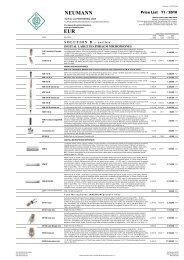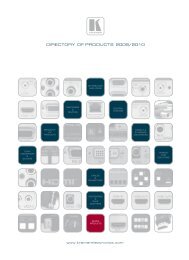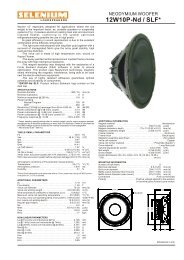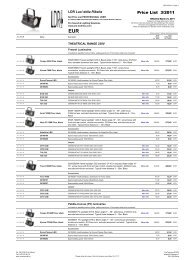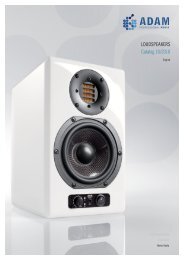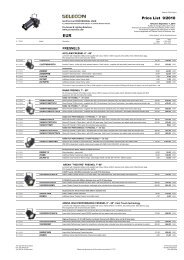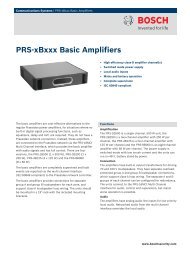Download - Yamaha Downloads
Download - Yamaha Downloads
Download - Yamaha Downloads
You also want an ePaper? Increase the reach of your titles
YUMPU automatically turns print PDFs into web optimized ePapers that Google loves.
DME Advantage #2<br />
Network Control<br />
Router, Source Selector, Matrix Mixer, and Audio Format Converter<br />
The vast array of studios, auxiliary control rooms, announcer's booths, video editing<br />
suites, and other facilities making up today's broadcasting stations must all be<br />
interconnected via a network, usually taking the form of analog cables. And although a<br />
standard procedure within stations, the reconfiguration of network connections for<br />
different applications is highly critical in nature and mistakes are simply unforgivable.<br />
Nevertheless, analog cables can be huge, often leading to extreme difficulty and<br />
complexity in connection, routing, and installation.<br />
When working simultaneously with multiple lines in a conventional analog network,<br />
broadcast engineers have to install dedicated routers, source selectors, matrix mixers,<br />
and other expensive gear. Using a <strong>Yamaha</strong> digital mixing engine, however, you can<br />
freely and flexibly call up practically any number of built-in routers, source selectors,<br />
and matrix mixers for integration into a network. Where necessary, these configurations<br />
can also be stored and later recalled using your PC or a wide assortment of<br />
intuitive controllers. Thanks to this sophisticated approach, it is little wonder that the<br />
DME Series allows network operations to be carried out with superior levels of<br />
efficiency, practically no potential for error, and ease-of-use that is second to none, all<br />
without compromising its stunning sonic performance.<br />
With four slots for mini YGDAI (MY) cards on the rear panel of the DME64N and one on<br />
the DME24N, this series offers a wholly-flexible open structure for the input and output<br />
of audio signals. You can freely select MY cards based not only on the required number<br />
of input and output channels, but also on the audio formats needed for the application<br />
in question. As such, <strong>Yamaha</strong>'s digital mixing engines make easy work of conversion<br />
between numerous digital and analog formats.<br />
Multichannel Router<br />
Announcers' booth 1<br />
Announcers' booth 2<br />
Announcers' booth 3<br />
DME’s User Control Panel allows routing operation intuitively by touch panel.<br />
High-definition video recorders, which have become increasingly popular in recent years, can also record eight tracks of audio; accordingly, these<br />
devices are often used to record the six channels of standard 5.1 surround sound together with a stereo mix. The configuration below is a typical<br />
example of how the DME Series can route eight channels as one for just such an application. As shown, a simple, intuitive control panel can be used to<br />
select a source from among many groups of eight channels and to also specify the ultimate destination of these audio signals. And if necessary, input<br />
and/or output level meters can easily be added to the configuration for monitoring of sound levels.<br />
Editorial room<br />
VTR 1<br />
VTR 2<br />
VTR 3<br />
EX) PM1DV2<br />
Main console<br />
Router, Sou rce Selector,<br />
Patch Panels,<br />
Matrix Mixer, Meter, etc.<br />
Console Console<br />
EX) DM1000VCM<br />
EX) DM1000VCM<br />
Format<br />
Converter<br />
Editorial room<br />
VTR 1<br />
VTR 2<br />
VTR 3<br />
Studio A<br />
Router, Source Selector,<br />
Matrix Mixer, Meter, etc.<br />
Studio B<br />
Router, Source Selector,<br />
Matrix Mixer, Meter, etc.<br />
It is customary in broadcasting applications that audio be exchanged between<br />
individual processing sections in multichannel format, often employing 4<br />
channels. And if surround sound must also be supported, the number of<br />
network channels will increase accordingly. As a solution for fail-safe,<br />
efficient, and inherently reliable control of these multichannel networks,<br />
nothing beats configurations setup on a DME64N.<br />
Example: AES/EBU 8chI/O(75 BNC) <br />
AES/EBU 8chI/O (with sampling rate converter)<br />
a-dat 16chI/O AES/EBU 16chI/O<br />
Format Converter<br />
Matrix Mixer<br />
With a 64x64 channel matrix mixer as shown above, you can freely assign any source to any output<br />
channel and also adjust their levels as required. Even the most complex of configurations can, therefore,<br />
be easily and efficiently setup via an easy-to-understand graphic interface on your PC. What's more,<br />
numerous configurations created in this way can be conveniently stored in memory and instantly recalled<br />
whenever the situation demands.<br />
A vast assortment of digital devices is regularly put to use in today's broadcasting and music production studios. While exchange between devices<br />
is never an issue with analog signals, the diverse range of formats that exist for digital audio can give rise to serious compatibility problems, and<br />
it's not unusual to see multiple format converters used side-by-side in order to resolve incompatibilities. Rather than using expensive,<br />
mono-functional format converters in this role, however, it is far more efficient and economical to take advantage of the open configuration for<br />
signal input and output afforded by the DME Series. The DME64N, for example, has four slots for mini-YGDAI (MY) cards, while the DME24N has<br />
one. MY cards can thus be freely selected to convert between different audio formats and<br />
channel numbers with a high degree of precision and flexibility. Aside from high-quality<br />
96-kHz/24-bit AD/DA conversion, the MY card series also provides support for ADAT, TASCAM,<br />
AES/EBU, MADI, CobraNetTM. In order to cater for a wide variety of possible applications, these<br />
digital I/O cards have been made available in both 8- and 16-channel versions. With its four MY<br />
slots, therefore, the DME64N can be provided with as many as 64 digital I/O channels.<br />
Example: AES/EBU 40chI/O a-dat 16chI/O<br />
Example: MADI 16chI/O AES/EBU 16chI/O<br />
a-dat 16chI/O TDIF 16chI/O<br />
Turn to page 49 for information on how to download and install DME Designer.<br />
11 12



